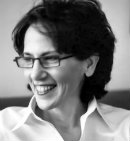Mindful Teaching Leads Us to Great Artistry
 By Linda Mancia
By Linda Mancia
In June, I retired from a nearly 25-year second career in education. As I was preparing what to say to my colleagues in my retirement speech, I was struck by the realization that I have been teaching since 1960.
I was seven years old in 1960. I’d run home from Sister Mary Charles’ 2nd grade class at the Little Flower Catholic Elementary School in Brooklyn, New York. I’d first complete my homework, and then, in the hour or so that remained before the family dinner, I’d enter the pedagogical world of my imagination.
 I’d put on my nun’s habit, which had evolved in under 3 years from a bath towel, a Kleenex and two black bobby pins to an elaborate array of sheets, cardboard, beads, belts and robes that was quite impressive in its final form.
I’d put on my nun’s habit, which had evolved in under 3 years from a bath towel, a Kleenex and two black bobby pins to an elaborate array of sheets, cardboard, beads, belts and robes that was quite impressive in its final form.
The student/teacher ratio in the school of my imagination was quite good: 24 to 1 – far better than reality (I was #52 of 60 in my 2nd grade class). My students were each represented by a sheet of paper in three neatly placed rows of four on each twin size bed. Each student was assigned a name. The names, as I recall, were randomly selected from words in the dictionary.
The first name I made up using the first letter of the first word of the definition. So there was Linda Sneed, the smartest in the class with my initials, of course. Michael Knead – K N E A D (the kind of student who would often tie your stomach into knots); and then there was another student – I sensed a boy of Italian descent (like myself) who did not fare very well (since this was before 1975 and special education legislation). His name was Vincent DE-Bacle.
What this little snapshot of my life as a child shows is the enormous impact that teachers have on their students. There are the obvious ways – your personality, your sense of humor, how much homework you give. But there are ways that are far more subtle that seem to affect students long after they have left you.
► How carefully you prepared your lessons teaches pride in quality and in working hard.
► How flexible you were depending on circumstances teaches the importance of tempering reason and steadfast principle with empathy.
► How you – nervous with anticipation – tried new instructional strategies that you learned on the days they were off and you weren’t teaches the importance of taking responsible risks.
► How you admitted to not knowing or to making a mistake and then using their feedback to make your teaching better teaches the importance of self-reflection in growing as a learner.
► And, the most surprising of all, how much you expected of yourself as a teacher was reflected in how much they seem to have expected of themselves as learners and how upset they would become when they disappointed you.
We have undeniable power
All those things I learned well, after I started teaching and went through the rough and tumble of the early years. I daresay it is this undeniable power we educators have that is the reason why we are under such public scrutiny.
As long as this model of education remains, no state mandate, no assessment test, no teacher evaluation system, no political administration will ever take away from us the power we have to impact the future of this country by how we choose to influence our students (or our colleagues) with the model of professional learning we set for them in our classroom (or in our roles) each and every day.
 It was past the mid-point of my career, when I became an administrator, that I learned the mystery behind why we do this challenging, stressful work. As I observed each teacher in my department, I began to realize that teachers are artists.
It was past the mid-point of my career, when I became an administrator, that I learned the mystery behind why we do this challenging, stressful work. As I observed each teacher in my department, I began to realize that teachers are artists.
Each teacher applies the paint to the canvas differently, varies the composition, the theme, the message. But when the art is fine art the results are unmistakable – the energy in the classroom is palpable.
And to experience this as the teacher, let alone as an observer, just makes the soul feel its worth. It is the reason I returned each September for 24 years.
Staying mindful: Teachers are learners too
In the year before I decided to retire from education, as I was packing up to leave my home of 33 years, I came across a copy of the application I completed for my teaching job in my district in 1996. When I turned to the section where you had to write about your philosophy of education, I braced myself for the sweet idealism of a still-youthful mother of 42 yearning to be what she had ached to be since she was a little girl.
But I was surprised to find that what I had written in that application was what I had followed as guiding principles throughout my entire career: the role of a teacher is to teach students how to learn and be literate in their discipline, to model as a master learner how you read, write and think, and to have students become active in the process of becoming independent thinkers.
 Then I saw the overly used phrase—to develop lifelong learners – and for the first time I saw not only my students but myself as one of those learners, and I somehow felt at that moment that it was time.
Then I saw the overly used phrase—to develop lifelong learners – and for the first time I saw not only my students but myself as one of those learners, and I somehow felt at that moment that it was time.
Mindful living is necessary for continuous growth, but also essential for teaching and leading to be effective. Too often the obstacles in our way as educators are of our own making.
But, after a career in education, I have realized that those obstacles can be overcome with the simple faith in what we can learn – from our students, from each other, but mostly from ourselves.
__________
Linda Mancia is a retired educator from the Pelham Public Schools in Westchester County, New York, where for 24 years she taught Social Studies, reading and writing to middle and high school students, and worked in administration as a department supervisor and staff developer. She previously held a career as a developmental editor and then a freelance writer in educational publishing.
While raising a young family Linda decided to pursue a teaching career and earned a masters degree in literacy. Using social studies as a vehicle, she focused foremost on transforming her students into better readers, writers, and thinkers. Linda now lives in Bronxville, New York, and West Stockbridge, Massachusetts, with her husband John and dog Weston.


































Beautifully said, Linda!